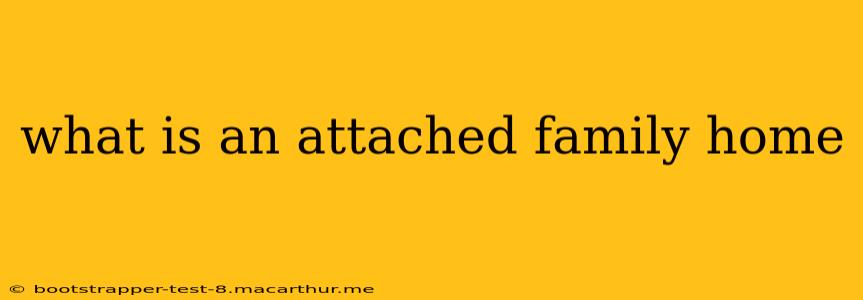An attached family home refers to a residential dwelling that shares one or more walls with another dwelling. Unlike detached homes, which stand alone, attached homes are part of a larger development or community. This shared-wall characteristic significantly impacts various aspects of homeownership, from cost and maintenance to lifestyle and community interaction. Let's delve deeper into understanding different types of attached family homes and what sets them apart.
What are the different types of attached homes?
Several types of attached homes exist, each with its unique features and advantages:
-
Townhouses: These are multi-story homes, usually two or three levels, that share walls with neighboring units. They typically have private entrances and yards, but the shared walls mean less exterior maintenance and often a smaller footprint than a detached home.
-
Row Houses (or Rowhomes): Similar to townhouses, row houses are attached homes arranged in a continuous row. They often share common walls on both sides and can vary in size and number of floors. They typically lack a front or backyard.
-
Condominiums (Condos): While condos can be attached or detached, attached condos are frequently part of a larger complex. Owners typically own the interior of their unit and share ownership of the common areas, like hallways, landscaping, and recreational facilities. Homeowners association (HOA) fees are usually associated with condo ownership.
-
Duplexes: These buildings consist of two separate living units, usually sharing a common wall. One unit might be owned, while the other is rented, or both units could be owned by separate parties.
What are the pros and cons of attached family homes?
The decision to buy an attached family home hinges on weighing the advantages and disadvantages against personal needs and preferences.
Pros:
- Affordability: Attached homes are often more affordable than detached homes, especially in desirable locations. Shared walls and smaller lots reduce construction and land costs, passing those savings onto the buyer.
- Lower Maintenance: Less exterior maintenance is typically required since you share walls with your neighbors. This means less time and money spent on upkeep.
- Community Feel: Living in an attached home often fosters a stronger sense of community. Proximity to neighbors can lead to increased social interaction.
- Amenities: Many attached home developments offer shared amenities like pools, playgrounds, and community centers.
Cons:
- Less Privacy: Shared walls inevitably lead to less privacy than a detached home. You might hear noises from your neighbors, and shared walls can impact noise insulation.
- HOA Fees (for some types): Condominiums and some townhouse communities have HOA fees, which can add to the monthly housing costs. These fees cover maintenance of common areas and other community services.
- Shared Walls: Issues with neighbors can arise more easily due to the shared walls. Disputes over noise, repairs, or maintenance are more common in attached homes.
- Limited Customization: Because they are part of a larger development, customization options for attached homes are usually more limited compared to detached homes.
What are the costs associated with attached family homes?
Costs vary significantly depending on location, size, and the specific type of attached home. However, generally, the purchase price is lower than that of a comparable detached home. Ongoing costs might include:
- Property Taxes: These are assessed based on the property value.
- HOA Fees (if applicable): These fees cover maintenance of common areas and amenities.
- Utilities: These costs depend on the size of the home and energy efficiency.
- Insurance: Home insurance costs vary by location and the home's value.
- Repairs and Maintenance: While exterior maintenance is often less, interior repairs and maintenance remain the owner's responsibility.
Is an attached family home right for me?
The best type of home for you depends on your lifestyle, budget, and priorities. Consider these factors:
- Your Budget: Are you looking for a more affordable housing option?
- Your Lifestyle: Do you prefer a strong sense of community or value your privacy above all else?
- Maintenance Preferences: Are you willing to handle some home maintenance, or do you prefer a low-maintenance option?
- Location: Are you looking for a specific location where detached homes are prohibitively expensive?
By carefully weighing these factors and understanding the nuances of different types of attached homes, you can make an informed decision about whether this type of housing is the right fit for your needs.
